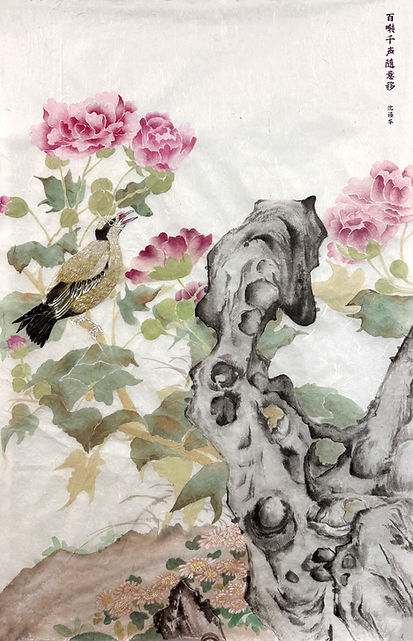
Cathy Shen, 2024
Chinese Traditional Painting
Theme: Flowers and Birds
Technique: Boneless (Mogu)
Material: Processed Silk
Peonies and Magnolia

Oriole Heralding Spring
Cathy Shen, 2024
Chinese Traditional Painting
Theme: Flowers and Birds
Technique: boneless (Mogu)
Material: 90% Matured Xuan Paper

Remnant Lotus at Summer's End
Cathy Shen, 2023
Chinese Traditional Painting
Theme: Flowers and Birds
Technique: boneless (Mogu)
Material: 90% Matured Xuan Paper
Boneless Painting (Mogu Painting)
Boneless painting (Mogu technique) is a traditional Chinese painting method primarily used for flower and bird paintings, though it can also be applied to landscape and figure paintings. This technique directly uses color or ink to paint flowers and leaves without "brush bones"—meaning without ink line outlines. As an important technique in traditional Chinese painting, the historical development of boneless painting can be traced back to the Northern and Southern Dynasties period (420-589 CE), gradually maturing through innovations by painters throughout the dynasties.
Boneless painting differs from both meticulous brushwork (gongbi) and freehand brushwork (xieyi). The character "没" (mo) in "没骨" means "submerged" or "concealed," with its essence lying in the organic fusion of brushwork and color application. It requires no outline sketching, no preliminary drafts, and absolutely no tracing from underlying patterns. When painting, the artist must have a complete mental image and execute the work in one continuous flow.
In calligraphy, the path traced by the brush tip is called "bone," while the remaining parts are called "flesh." Boneless painting integrates ink, color, water, and brushwork into a unified whole, skillfully combining them on paper with emphasis on implicit meaning and following the natural flow of brushstrokes.
Key Differences Between Boneless Painting and Common Chinese Painting Techniques
The distinctions between boneless painting and the commonly used techniques of meticulous brushwork (gongbi) and freehand brushwork (xieyi) are primarily reflected in their technical core, expressive methods, and artistic effects:
1. Technical Core
-
Boneless Painting: Directly shapes forms using colors or ink blocks, completely abandoning ink line outlining, emphasizing the fusion of water and color.
-
Meticulous Brushwork (Gongbi): Based on ink line outlining, with layered color application in distinct steps.
-
Freehand Brushwork (Xieyi): Led by brushwork and ink, emphasizing brush-ink interest and emotional expression without being confined to details.
2. Line Treatment
-
Boneless Painting: Conceals lines, directly shaping objects through color blending.
-
Meticulous Brushwork: Clear and precise lines, focusing on accurate outline depiction.
-
Freehand Brushwork: Free brushstrokes, often using concise brush-ink to capture objects. characteristics
3. Coloring Methods
-
Boneless Painting: Often uses plant pigments, emphasizing water-color layers and transparency, combining colors with ink blocks.
-
Meticulous Brushwork: Mineral pigments applied repeatedly, with saturated colors and distinct layers.
-
Freehand Brushwork: Primarily focuses on ink tone variations, often using splashed ink and broken ink techniques to express artistic conception.
4. Artistic Effects
-
Boneless Painting: Achieves both form and spirit, with subtle and gentle imagery, approaching freehand style while maintaining accurate form.
-
Meticulous Brushwork: Neat and delicate with decorative qualities, emphasizing detailed formal resemblance.
-
Freehand Brushwork: Emphasizes imagery and artistic charm, pursuing the conception of "excellence lies between likeness and unlikeness."
In essence, boneless painting is often considered an expressive style between meticulous and freehand brushwork, preserving the delicate texture of meticulous work (such as precise depiction of petal layering relationships) while possessing the dynamic charm of freehand expression.
Core Dyeing Techniques in Boneless Painting
The dyeing techniques in boneless painting form the core of its methodology, achieving object modeling through layered color-ink application and moisture control. These can be categorized into the following key techniques:
I. Layered Dyeing and Mixed Dyeing Techniques
Base Color Foundation: First apply light ink or pale colors as a base (such as using indigo mixed with light ink to dye leaves), then after drying, apply gradually darker colors in layers, creating three-dimensional effects through multiple washes. The refined boneless method often requires covering pencil drafts, ultimately concealing all line traces.
Gradual Transition Dyeing: Using two brushes for blending (one with deep red, one with light red) to achieve natural gradation from deep to light on petals.
II. Color Breaking and Color Collision Techniques
Breaking Ink and Color: While wet, using concentrated color to break into light color (such as using ochre to break into indigo at leaf tips), creating natural textures of withering and flourishing changes.
Water and Powder Collision: Adding water or dots of powder to undried color blocks (such as adding white powder to wet petals), producing transparent texture and three-dimensional effects.
III. Moisture Control and Edge Treatment
Precise Moisture Application: Raw rice paper requires quick brushwork, while sized paper suits refined blending. Moisture must achieve "moist without bleeding, dry without withering."
Preventing Color Bleeding: Leave fine gap lines where two colors meet, or apply colors at intervals to prevent color mixing.
IV. Line Addition and Form Completion Techniques
After color application is complete, similar colors can be used to add leaf veins and flower patterns (such as using light vermillion to outline pink flower veins). Lines must dissolve into colors and not float on the surface.
This comprehensive technique creates paintings that are both technically sophisticated and artistically expressive, representing a unique achievement in traditional Chinese painting methodology.





